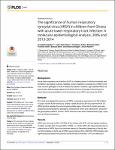The significance of human respiratory syncytial virus (HRSV) in children from Ghana with acute lower respiratory tract infection: A molecular epidemiological analysis, 2006 and 2013-2014
Obodai, Evangeline
Odoom, John Kofi
Adiku, Theophilus
Goka, Bamenla
Wolff, Thorsten
Biere, Barbara
Schweiger, Brunhilde
Reiche, Janine
Background:
Acute lower respiratory tract infection (ALRI) is a leading cause of childhood morbidity and mortality in developing countries. Globally, human respiratory syncytial virus (HRSV) is the most common pathogen of ALRI in infants and children. However, age-stratified HRSV disease burden data are largely absent from Africa, which is a key gap in informing an evidence-based recommendation for the introduction of an HRSV vaccine by the WHO.
Methods:
This study investigated the presence of HRSV in respiratory specimens from 552 children <5 years old with ALRI from Accra, Ghana in 2006 and 2013–2014 by real-time PCR. Of HRSV-positive samples the second hypervariable region of the viral G protein gene was sequenced and analyzed for phylogeny, characteristic amino acid substitutions, and potential glycosylation patterns. Further, HRSV infections have been characterized by age, symptoms and timely occurrence.
Results:
HRSV was observed in 23% (127/552) of the children with ALRI, with the highest incidence in infants younger than one year (33%, 97/295, p = 0.013). Within the observed seasonal circulation time of HRSV from June (mid-wet season) to December (beginning of the dry season) the incidence of ALRI due to HRSV was as high as 46% (125/273). HRSV disease was significantly associated with (broncho-) pneumonia, bronchiolitis, LRTI, and difficulty in breathing. Phylogenetic characterization of HRSV strains from Ghana identified the circulation of the currently worldwide prevailing genotypes ON1 and BA9, and shows evidence of an independent molecular evolution of ON1 and BA9 strains in Ghana resulting in potentially new subgenotypes within ON1 and BA9, provisionally named ON1.5, ON1.6, and BA9-IV.
Conclusion:
This study addresses important knowledge gaps in the forefront of introducing the HRSV vaccine by providing information on the molecular evolution and incidence of HRSV in Accra (Ghana, Africa).
Dateien zu dieser Publikation

